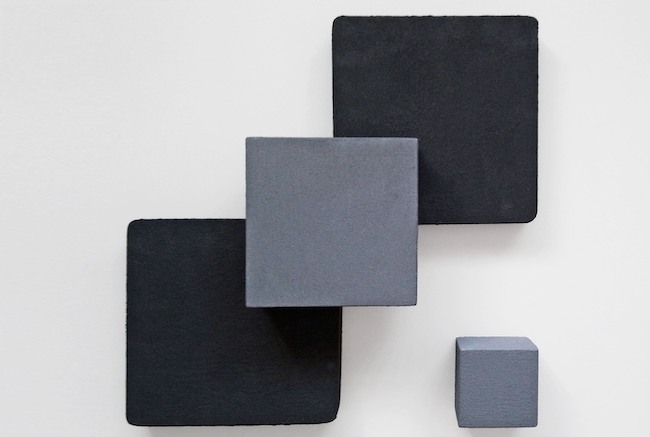La tendenza a esplorare la realtà non per ciò che si vede bensì per il significato che si nasconde dietro di essa può generare negli artisti due tipi di reazioni espressive: una che tende verso il caos, l’impossibilità di trattenere tutte quelle sensazioni che irrompono sulla tela come se l’esecutore dell’opera ne fosse solo il braccio esecutivo, e l’altra che al contrario necessita di un’assoluta schematizzazione, di un determinismo all’interno del quale quel senso profondo possa in qualche modo trovare contenimento e solo in una seconda fase, spesso successiva, conceda all’autore, o all’osservatore, di entrare all’interno di un sé che diversamente non potrebbe esprimersi. In entrambi i casi la scelta non può che vertere verso l’Arte Informale, verso una non forma necessaria a distaccarsi dal visibile e perdersi nell’atto creativo. Il protagonista di oggi non solo opta per la scelta più razionale spingendosi verso un Astrattismo Geometrico in cui le forme si alternano e sovrappongono in un richiamo quasi ipnotico, ma entra nel mondo della materia introducendo la terza dimensione attraverso la quale riesce ad aggiungere l’interazione della luce e dell’ombra creando moduli in apparente movimento.
Il periodo del primo ventennio del Novecento fu un susseguirsi di sperimentazioni artistiche perché l’imperativo era rompere gli schemi con tutte le regole accademiche su cui si era basata l’arte fino a poco prima, ma anche trovare innovativi modi di reinterpretare un’espressione creativa che avvertiva la necessità di stare al passo con i tempi, con quel vivace periodo di scoperte e di progresso tecnologico che strideva con la più tradizionale arte figurativa alla ricerca costante della bellezza. Il concetto della scomposizione dell’immagine, che fu caratteristica distintiva dell’Impressionismo prima e del Puntinismo e del Divisionismo poi, benché questi movimenti fossero ancora legati alla rappresentazione della realtà osservata, diede di fatto inizio a tutte le successive ricerche sulla frammentazione dell’oggettività in blocchi via via più grandi, conducendo al Futurismo e al Cubismo, laddove il legame con ciò che lo sguardo coglieva dovesse essere ancora presente, e infine alla scomposizione più totale che determinò il distacco completo dal visibile decretando la nascita dell’Astrattismo, dove la realtà circostante non doveva più esistere e ciò che contava era il gesto plastico, la ricerca di un ordine necessario per portare in primo piano l’arte fine a se stessa, senza che fosse più mera riproduzione dell’osservato. Il De Stijl in Olanda e il Suprematismo in Russia sottolinearono quanto un dipinto potesse essere perfettamente equilibrato e plasticamente ammirabile anche attraverso la sola presenza dei colori primari e delle forme geometriche che richiamavano all’ordine essenziale e all’importanza del costruire attraverso linee verticali e orizzontali senza la necessità di personalizzare l’opera con la soggettività dell’esecutore. Il medesimo approccio si ebbe anche dal punto di vista architettonico attraverso l’emergere del Razionalismo, caratterizzato da strutture geometriche e dall’introduzione di vetri per determinare un’alternanza tra vuoto e pieno che fosse però puramente funzionale, privo di ogni aspetto decorativo come era stato invece per l’Art Déco. È esattamente in queste radici che si colloca lo stile dell’artista milanese Stefano Paulon, il quale riprende l’essenzialità del De Stijl, introducendo tuttavia anche la forma circolare che da Piet Mondrian era stata invece completamente abolita perché considerata ambigua, ma assorbendo l’esperienza architettonica del Razionalismo per spogliare le sue opere di qualsiasi decoratività, persino rinunciando al colore, e introdurre la terza dimensione, quella in virtù della quale riesce ad arricchire i suoi lavori dell’alternanza di rilievi più o meno pronunciati che enfatizzano la simmetria dei suoi lavori.
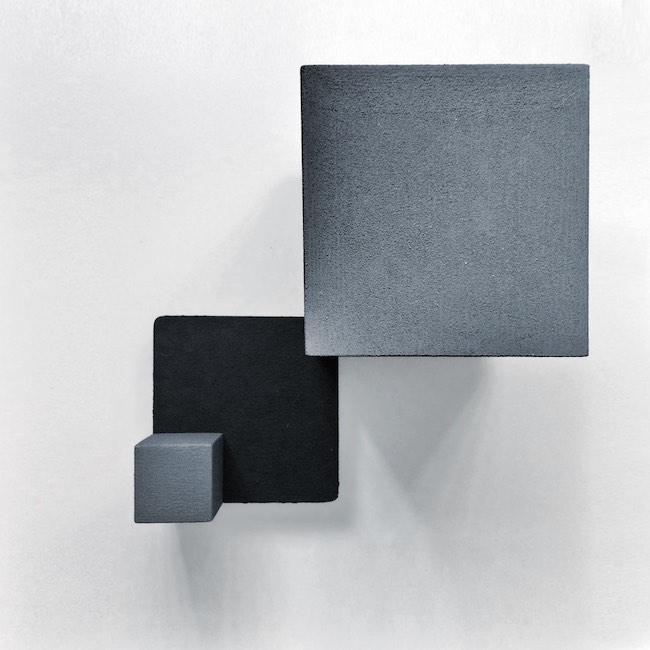
Eppure, proprio grazie alla presenza di quella tridimensionalità e dunque cambiando punto di osservazione, l’equilibrio schematicamente perfetto si modifica facendo fuoriuscire una nuova opzione, quella dell’asimmetria che corrisponde al possibilismo in grado di manifestarsi anche in presenza di un rigore apparente, anche laddove il determinismo sembra dominare la scena. Non solo, Stefano Paulon, scegliendo di eliminare il colore per catalizzare l’attenzione verso la perfezione della pura forma, lavora in scala di grigi che di fatto contribuiscono a puntare ancor più l’accento sulla costante ricerca di un bilanciamento tra luce e ombra, tra il desiderio di emergere e quello di rimanere in silenzio, tra la necessità di essere parte di un tutto e il coraggio di mantenere comunque una propria identità.
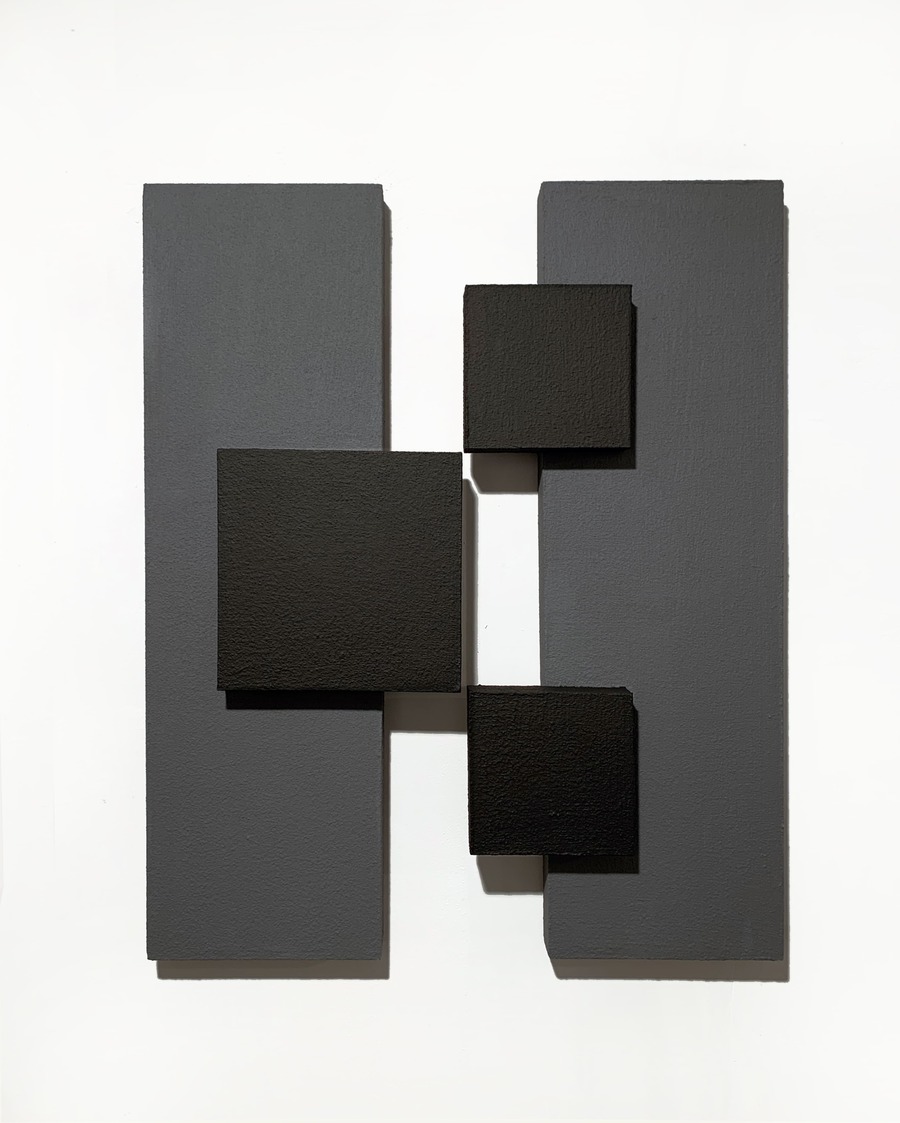
Dunque il Concettualismo di Paulon fa capolino a un secondo sguardo, le opere divengono ipnotiche proprio perché attraggono l’attenzione verso un trasformismo che sembra quasi entrare in contrasto con il rigore teorizzato da Piet Mondrian, il quale addirittura non concepiva la linea obliqua, perché qui tutto sembra essere solo apparentemente immobile, solo superficialmente rigoroso e schematico, solo temporaneamente isolato nello spazio.
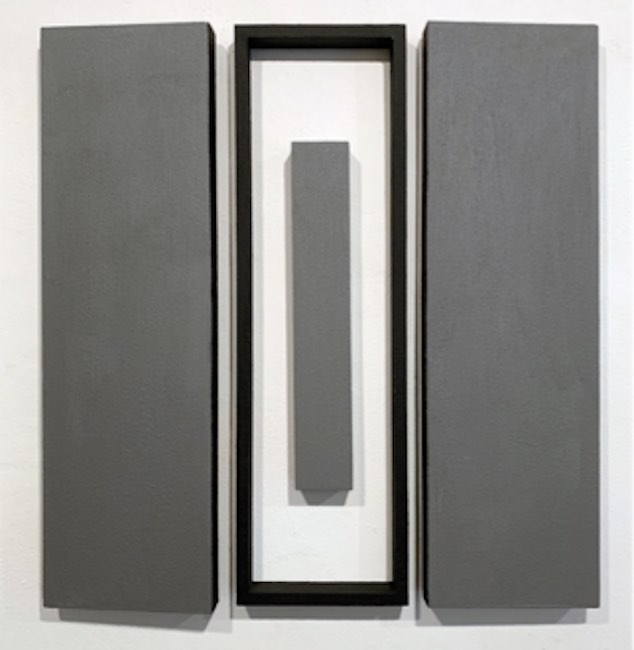
In realtà la comunicazione sembra essere una dominante delle sue opere, quel cercare una connessione, un legame costante tra le varie figure geometriche, come se esse fossero metafora dell’essere umano di ogni tempo che ha bisogno di appartenere a un gruppo, a un insieme, per non rischiare di trovarsi completamente isolato; pertanto figure più grandi sembrano attrarre le più piccole, le chiamano a sé per indurle a non perdersi nella solitudine dello spazio che le circonda, tanto quanto la forma quadrata sembra voler contenere quella circolare che tende a fluttuare verso altro spazio, quello più affine a sé, quello in cui voler restare.
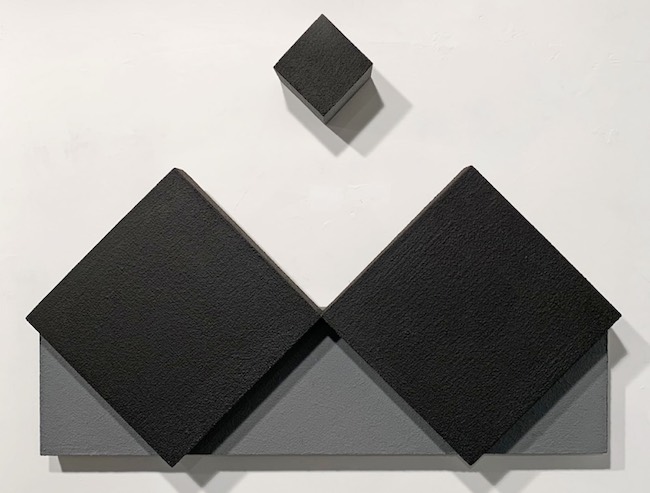
L’essenzialità dell’opera di Stefano Paulon e la sua apparenza razionale e persino scientifica si vanno a sfumare così dentro a quei concetti nascosti, quell’emozionalità silenziosa, e forse quasi inconsapevole da parte dell’autore, che inevitabilmente si svela nella fase in cui lo sguardo viene calamitato dalla suggestione ipnotica di quei volumi alternati, di quel susseguirsi di rilievi, di spazi vuoti a volte da colmare altre invece da mantenere per enfatizzare la possibilità di sussistenza di tante opzioni parallele ugualmente reali e ammissibili. E poi, in alcune installazioni, Paulon dà inaspettatamente spazio all’elemento imprevisto, alla rottura di uno schema provocato da quell’eccezione che sembra confermare la regola, da quella voce fuori dal coro che si distingue, ecco perché l’introduzione del colore rosso, e che trova il coraggio di porsi come portatore di una verità differente da quella comunemente accettata;
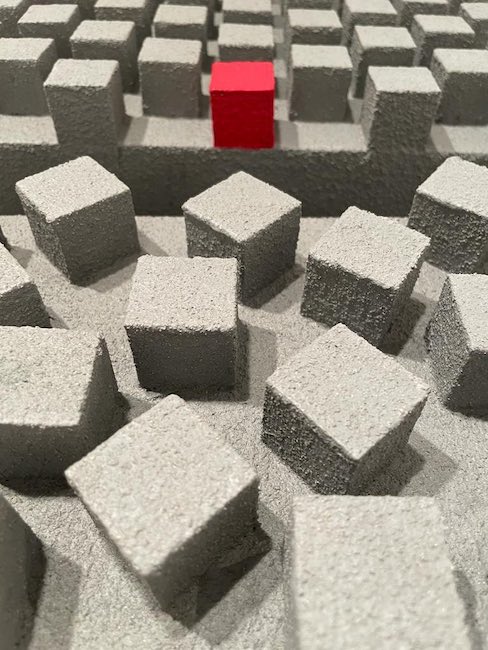
in qualche modo da questo tipo di opere emerge un’arguta analisi della società contemporanea in cui troppo spesso l’individuo si adegua a una versione della realtà solo perché frutto di un pensiero comune, spesso volutamente generalizzato, dimenticando di compiere una personale riflessione su ciò che accade intorno e che può trovare un senso diverso e spesso persino opposto, se solo l’uomo continuasse a mantenere vivo il proprio pensiero critico. Ecco, quell’elemento geometrico rosso corrisponde esattamente a quei soggetti che scelgono di non adeguarsi, di non conformarsi a un generalismo sempre più spersonalizzante.
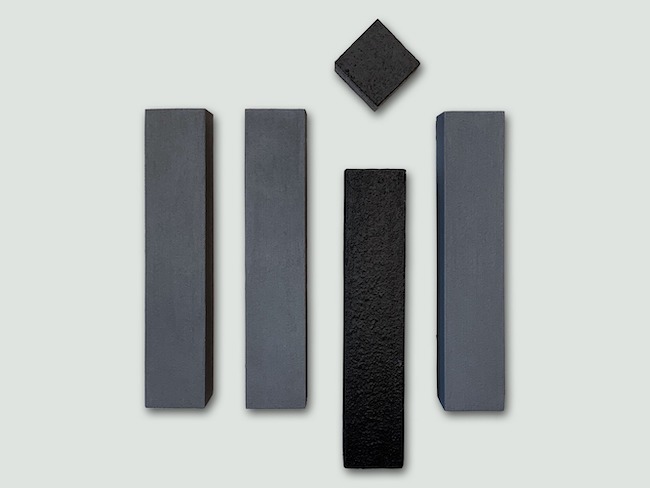
Dunque il Razionalismo, l’Astrattismo Geometrico, il Concettualismo che contraddistinguono lo stile di Stefano Paulon divengono un mezzo che egli utilizza per scendere all’interno di sé in maniera logica nell’aspetto esteriore ma poi, man mano che si spinge in profondità e mentre l’opera prende forma, il percorso diviene più empatico, sensibile nell’osservazione di ciò che ruota intorno e che in maniera sottile e a volte ermetica ha bisogno di venire alla luce e manifestarsi tra le linee e gli angoli dei suoi volumi geometrici. Le opere, fortemente materiche, sono costituite da strutture in legno o cartone, prevalentemente di recupero, su cui poi Stefano Paulon appone diversi strati di materiale cementizio a base acrilica con finiture al fresco o con pigmenti puri miscelati alla cera naturale a caldo; l’effetto finale ha un aspetto leggero ma incredibilmente solido, i suoi lavori sono consistenti eppure il peso è inferiore a quanto si possa immaginare perché il rivestimento in cemento costituisce solo lo strato superficiale della composizione.
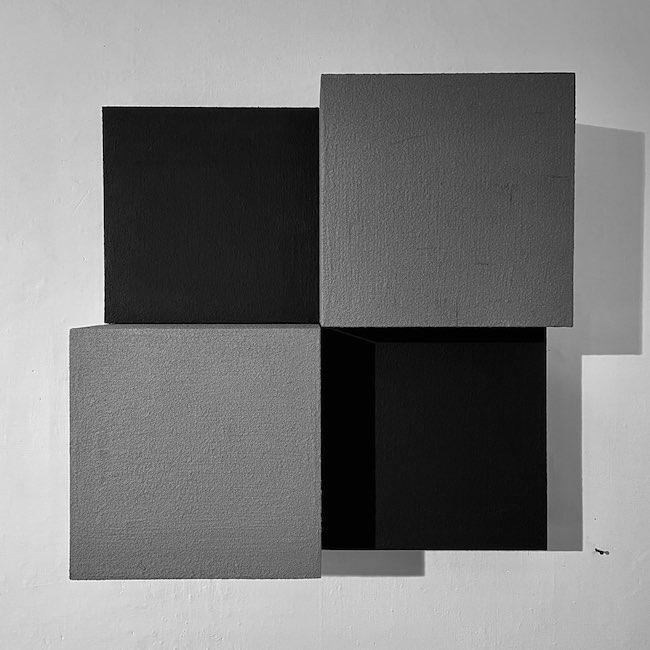
Stefano Paulon ha al suo attivo un percorso espositivo che lo ha visto protagonista di mostre personali, e collettive, in Italia e all’estero, sia in gallerie private che presso enti pubblici, come nel caso della sua mostra antologica presso la Sala Espositiva di Santa Maria della Misericordia a Perugia patrocinata dal Comune di Perugia e che avrà luogo dal 1° al 31 marzo 2024.
STEFANO PAULON-CONTATTI
Email: stefano.paulon@gmail.com
Facebook: www.facebook.com/stefanopaulon
www.facebook.com/stefanopaulonarchive
Instagram: www.instagram.com/stefanopaulon/
The elegance of geometric form in the evocative artworks by Stefano Paulon, between Informal rigour and Conceptualism that challenges rationality
The tendency to explore reality not for what is seen but for the meaning behind it, can generate two types of expressive reaction in artists: one that tends towards chaos, the impossibility of retaining all those sensations that burst onto the canvas as if the executor of the artwork were only its executive arm, and the other that on the contrary requires absolute schematisation, a determinism within which that profound sense can somehow find containment and only in a second, often subsequent phase, allows the author, or the observer, to enter inside a self that otherwise could not express itself. In both cases, the choice can only be towards Informal Art, towards a non-form necessary to detach oneself from the visible and lose oneself in the creative act. Today’s protagonist not only opts for the more rational choice by pushing towards a Geometric Abstractionism in which forms alternate and overlap in an almost hypnotic appeal, but also enters the world of matter by introducing the third dimension through which he manages to add the interaction of light and shadow, creating modules in apparent movement.
The period of the first two decades of the 20th century was a succession of artistic experimentation because the imperative was to break the mould with all the academic rules on which art had been based until recently, but also to find innovative ways of reinterpreting a creative expression that felt the need to keep up with the times, with that lively period of discoveries and technological progress that clashed with the more traditional figurative art in constant search of beauty. The concept of the decomposition of the image, which was a distinguishing feature of Impressionism first and Pointillism and Divisionism later, although these movements were still linked to the representation of observed reality, in fact initiated all subsequent research into the fragmentation of objectivity into progressively larger blocks, leading to Futurism and Cubism, where the link with what the gaze grasped still had to be present, and finally to the most total decomposition that determined the complete detachment from the visible, decreeing the birth of Abstractionism, where the surrounding reality no longer had to exist and what counted was the plastic gesture, the search for an order necessary to bring art to the foreground as an end in itself, no longer a mere reproduction of the observed.
De Stijl in the Netherlands and Suprematism in Russia emphasised how a painting could be perfectly balanced and sculpturally admirable even through the mere presence of primary colours and geometric shapes that recalled the essential order and importance of building through vertical and horizontal lines without the need to personalise the work with the subjectivity of the executor. The same approach was also taken from an architectural point of view through the emergence of Rationalism, characterised by geometric structures and the introduction of glass to determine an alternation between empty and full spaces that was, however, purely functional, devoid of any decorative aspect as had been the case with Art Deco. It is exactly in these roots that is placed the style of the Milanese artist Stefano Paulon who takes up the essentiality of De Stijl, introducing however also the circular form that had been completely abolished by Piet Mondrian because it was considered ambiguous, but absorbing the architectural experience of Rationalism to strip his artworks of any decorativeness, even renouncing colour, and introducing the third dimension, by virtue of which he is able to enrich his works with the alternation of more or less pronounced reliefs that emphasise their symmetry. And yet, precisely because of the presence of that three-dimensionality, and thus by changing the point of observation, the schematically perfect balance is modified by bringing out a new option, that of asymmetry, which corresponds to the possibilism capable of manifesting itself even in the presence of apparent rigour, even where determinism seems to dominate the scene.
Not only that, Stefano Paulon, choosing to eliminate colour in order to catalyse attention towards the perfection of pure form, works in greyscale, which in fact contributes to placing even more emphasis on the constant search for a balance between light and shadow, between the desire to emerge and the desire to remain silent, between the need to be part of a whole and the courage to nevertheless maintain one’s own identity. So Paulon‘s Conceptualism peeps out at a second glance, the artworks become hypnotic precisely because they attract attention to a transformism that almost seems to contrast with the rigour theorised by Piet Mondrian, who did not even conceive of the oblique line, because here everything seems to be only apparently immobile, only superficially rigorous and schematic, only temporarily isolated in space. In fact, communication seems to be a dominant feature of his works, that search for a connection, a constant link between the various geometric figures, as if they were a metaphor for the human being of all times who needs to belong to a group, to a whole, so as not to risk finding himself completely isolated; therefore, larger figures seem to attract the smaller ones, calling them to themselves so as not to get lost in the solitude of the space that surrounds them, just as the square shape seems to want to contain the circular one that tends to float towards another space, the one that is closest to itself, the one in which it wants to remain. The essentiality of Stefano Paulon‘s work and its rational and even scientific appearance are thus blurred within those hidden concepts, that silent emotionality, and perhaps almost unconscious on the part of the author, which inevitably reveals itself in the phase in which the gaze is drawn by the hypnotic suggestion of those alternating volumes, of that succession of reliefs, of empty spaces sometimes to be filled at others instead to be maintained to emphasise the possibility of the existence of many equally real and admissible parallel options. And then, in some installations, Paulon unexpectedly gives space to the unforseen element, to the rupture of a scheme caused by that exception that seems to confirm the rule, by that voice out of the chorus that stands out – hence the introduction of the colour red – and that finds the courage to present itself as the bearer of a truth different from the commonly accepted one; somehow from this type of artwork emerges a witty analysis of contemporary society in which all too often the individual conforms to a version of reality only because it is the result of a common thought, often deliberately generalised, forgetting to make a personal reflection on what is happening around and that can find a different and often even opposite meaning, if only man would continue to keep alive his own critical thinking.
Here, that red geometric element corresponds exactly to those subjects who choose not to adapt, not to conform to an increasingly depersonalising generalism. Therefore, the Rationalism, Geometric Abstractionism and Conceptualism that characterise Stefano Paulon‘s style become a means that he uses to descend within himself in a logical manner on the outside, but then, as he goes deeper and as the artwork takes shape, the path becomes more empathetic, sensitive in the observation of what revolves around and that in a subtle and sometimes hermetic way needs to come to light and manifest itself between the lines and angles of his geometric volumes. The strongly materialised works consist of wooden or cardboard structures, mainly salvaged, onto which Stefano Paulon then applies several layers of acrylic-based cement material with a fresh finish or with pure pigments mixed with hot natural wax; the final effect has a light yet incredibly solid appearance, his artworks are substantial yet the weight is less than one might imagine because the cement coating constitutes only the surface layer of the composition. Stefano Paulon has to his credit an exhibition career that has seen him take part in solo and group exhibitions in Italy and abroad, both in private galleries and at public institutions, as in the case of his anthological exhibition at the Sala Espositiva di Santa Maria della Misericordia in Perugia, sponsored by the Municipality of Perugia, which will take place from 1 to 31 March 2024.


